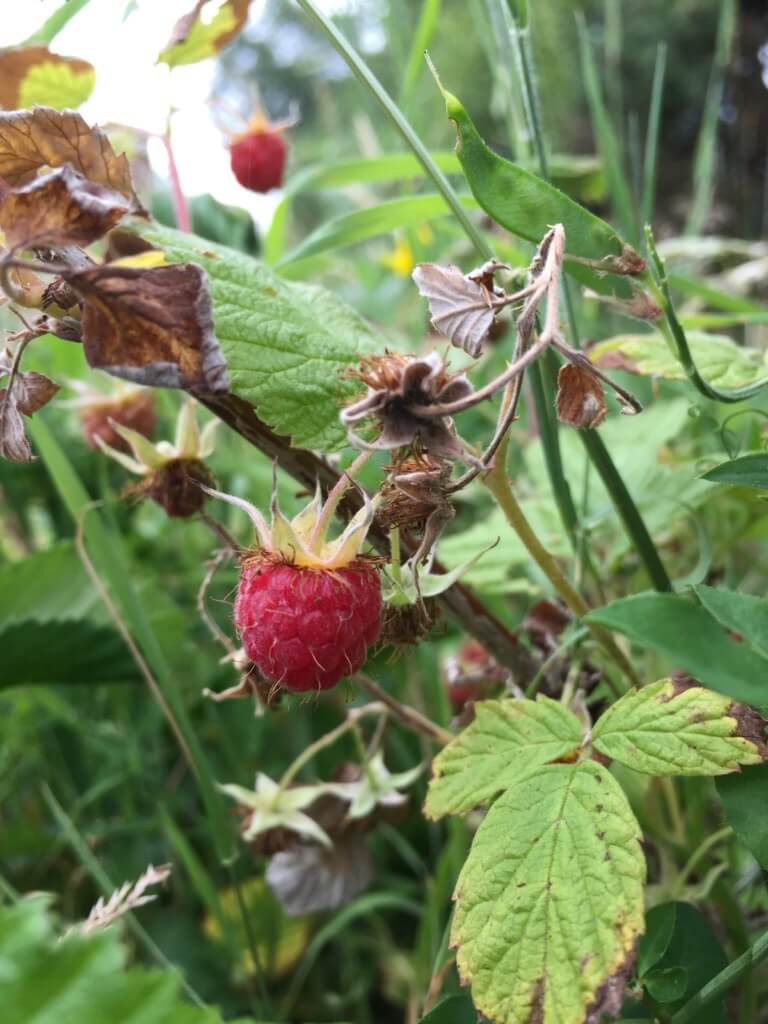
Having completed almost a full year of local gleaning and browsing I thought I’d round off this series with one of the best of all wild foods – one that can be found widely, if rather sparsely, across most of the country.
If they are not quite a match for the taste of wild strawberries (though these things are highly personal) the plants do at least produce good-sized fruits, approaching the size of the smallest cultivated raspberries. This similarity leads people to believe they are escapes from cultivation, even when found well away from civilisation. To the contrary, this is a genuinely wild, native plant, with a long history, and is all the more enjoyable for that.
The plants are not defended as heavily as brambles and the small thorns are less likely than their thuggish relative to shred your skin, or even your clothes, during the gathering process. Another advantage is their early season. The ripe fruits appear well ahead of the ubiquitous blackberry, from late June onwards in a good year. Now is the perfect time to look out for them in sunny woodland clearings, and along tangled, overgrown hedgerows.
—————————————————————————————————————————
Finally, any guesses as to the identity of this plant as described in three recently-published books on wild food?
‘…leaves and shoots make an excellent addition to fresh salads or can be cooked with spinach and other vegetables.’ (2018)
‘Don’t worry about their furry texture; this disappears completely during cooking. […] The young leaf spears, picked in March…make excellent salads, not unlike sliced cucumber.’ (2012)
‘…it is now considered to be quite seriously poisonous, causing dangerous liver conditions and even liver cancer.’ (2010)
Happy foraging.
[registration_form]
Guess the plant
“‘…it is now considered to be quite seriously poisonous, causing dangerous liver conditions and even liver cancer.’ (2010)”
That is fiddlehead ferns. I remember there being a big fuss in Japan about them being discovered to cause cancers.
As for the raspberries, there used to be a yellow rasps growing along several lanes in the town I grew up in. Then developers bulldozed them and the fields the lanes ran through to build “executive” homes. Not a single affordable (either “affordable” or genuinely affordable) home among them. A great lost of amenity for the community, all for the benefit of a few rich incomers. Come the revolution, I tell you!
Whilst I love a wild raspberry they are quite an invasive weed on the chalk grassland I help manage. They cause a dense shade blocking out light to plants below.
I must say I love raspberries and we grow quite a few in the garden here including yellow ones and some Autumn Bliss to extend the season. I have picked them wild but never found that many.
I too think the poisonous salad plant is fern shoots.
I’m sure you’re both right about the fern but the plant the three quotes refer to is the common and widespread Comfrey. It’s interesting that it was highlighted as a problem as early as 2010 but the later books seemingly ignore that information. There are a few fungi where the advice seems to have changed over the years and can be described as ‘edible’ or ‘poisonous’ depending on which book you read.
bracken?
comfrey
Giles – Yes. You’re only allowed to pick it if you promise not to eat it so I’m not surprised it’s familiar to you
makes a great mulch though Ian – and liquid fertiliser 🙂
Mark how about a blog post about Psilocybe semilanceata and other similar fungi.